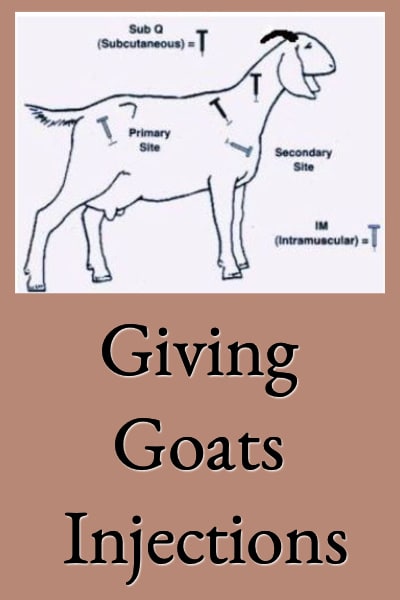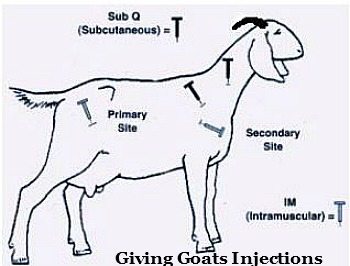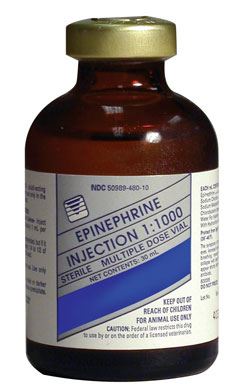
CD&T vaccinations, BoSe supplements, and antibiotics are all examples of things that your goats are likely to need that are administered via injection. Because goats need them on a regular basis and sometimes need them when a veterinarian may not be available, it’s important to learn how to do them. Having a veterinarian do them is both impractical and expensive.
Giving Goats Injections – 3 Types
There are three main methods for administering injections:
1) Intramuscular (IM): Injected deep into the muscle. Generally, a needle length of 1” to 1 1⁄2” and a gauge of 18 to 20 is used. Drugs administered IM absorb faster than subcutaneous (SQ) but slower than intravenous (IV).
For IM injections, select the injection site, stick the needle into the muscle, withdraw the needle slightly to ensure you haven’t hit a vein (if you have hit a vein, blood will be drawn into the syringe and you need to re-try a slightly different location) and push the plunger slowly. It’s a good idea to have someone familiar with giving injections IM demonstrate how it’s done before you attempt it on your own.
2) Subcutaneous (SQ): Injected under the skin. A needle length of 1⁄2” to 1” and a gauge of 20 to 22 is typically used. For SQ injections, use the “tent” method. Pick up the loose skin in the area of the injection. Holding the syringe and needle parallel to the body, push the needle through the skin layer and administer the medicine into the cavity created by the tent.
3) Intravenous (IV): Administer the medication into the vein. This method is not recommended for inexperienced owners as it’s often difficult to locate the vein.

Giving the Injection
It’ a good idea to have a supply of 3 ml and 6 ml (they’re the most commonly used size) disposable syringes and appropriate gauge needles on hand. The medication label should identify which one of the three methods above to use for the injection. If both IM and SQ are listed as acceptable methods, it’s generally given to the goats SQ because it’s usually easier to administer that way. Always use a new needle to inject each goat to avoid any possibility of spreading disease.
To draw the medication into the syringe, swab the top of the medication bottle with an alcohol-soaked pad, insert the needle into the top of the bottle, and withdraw the medication. Be sure to tap the syringe while drawing to get any air bubbles out. Restrain the goat (put on a milk stand or similar restraint) and select the injection site (see illustration above for recommended sites). After all the medication is administered, withdraw the needle and rub the area firmly but gently.
There are many other injectables such as vitamins and pain relievers that it may be necessary to administer via injection depending on the circumstances. Often, the situation needs to be dealt with quickly and a veterinarian may not be immediately available or would need to make an emergency (costly) farm visit to give the injection. It’s therefore highly recommended that goat owners learn to administer injections at least subcutaneously and not rely on their veterinarian for this service.

This is one medication that not good beyond the expiration date on the bottle, and you should always have an unexpired bottle of this around. Hopefully, you’ll never have to use it – I’m always happy when I throw away another expired bottle that never got used.
Tiffeny Norris says
Do you know if giving a kid LA 200 and CDT at the same time without having adverse reactions?
Lesa says
Hi Tiffan, LA 200 is an antibiotic so I don’t believe there should be negative reaction if given at the same time. However, LA 200 does “burn” when injected – Oxy-Tet 200 and Bio-mycin 200 are the same drug but use a different “carrier” that doesn’t sting as much. So, if you’ve got a choice, you might want to try one of the other oxytetracycline brands.
Michelle says
Do you have any advice on recovery after a nerve is damaged in an intramuscular injection, so that it causes paralysis? Should we be trying to stand our goat up supported or is he best left to rest?
Lesa says
Hi Michelle, I’m sorry that a nerve was damaged and caused paralysis. I don’t think i know enough about what nerve may have been damaged to comment, so I would recommend contacting your vet and asking.
Olagoke Taiwo says
That is the same problem am having..
After giving my goat IM injection, the goat leg bend..
I don’t know what to whether it will straight or not.
Yusuf Riliwan says
Please can I still use medication that is a month or two off the expiring dat subcutaneously (Ivermectin injection)
Lesa says
Hi Yusuf, generally medications are still ok a month or two after their expiration date; however, if you’re using Ivermectin to treat worms I’d just go get new Ivermectin. You don’t want to underdose when dealing with internal parasites like worms.
BJ says
I have two pregnant Boer goats that got (shipping fever) snotty noses after we got them home. We gave them LA 200 @ 4.5 ml SQ per 100 lbs and it’s day 4 now and they still have snotty noses. I bought Pen G to give them as instructions on LA 200 said to only give 4 days. I’m hoping Pen G will work. Any suggestions on antibiotic to use if I’m not getting results with LA 200 and Pen G doesn’t work.
Lesa says
Hi BJ, if neither of those work then I would call the Vet.
BJ says
Thank you Lesa. I got good results after changing to Pen G. I gave two extra days to be sure and all is well now.
Olagoke Taiwo says
You can use floxinor ( erofloxacin
Liz says
After giving our 4 Nigerian Dwarf kid goats the CD/T goats (SQ) under the arm pit they all lumps the size of a dime to a nickel, at the vaccination site.
Will these lumps go away? What is the cause? How can we avoid these in the future?
Lesa says
Hi Liz, Unfortunately getting a lump at the CD/T injection site is quite common and that’s probably the main reason the shot is given in the armpit region – so that the lumps don’t show as easily. They will go away with time. I believe it’s the goat’s bodies reaction to the introduction of a foreign substance. As far as avoiding them in the future, we have had fewer lumps when we switched to a different brand of CD/T shot. We have been using the Colorado Serum Company brand to try to minimize the lumps.
Deb Muscari says
Goats’ skin is so tight that I have a hard time finding loose skin to create a “tent.” Advice?
Lesa says
Try giving the injection in the “armpit” region of the goat’s front leg – the area on the back of front leg where at the base where the leg attaches to the body. There’s usually a little excess skin in that ar
Riliwan says
Try through the back of the shoulder
Valerie says
This is a great article and I appreciate the goat model.
Carrissa says
We just got our goats a few months ago and shots at blood draws have been the biggest challenges for me so far. Thanks for the great info!
Karen B. @ Making Shift says
Thanks you. This is super helpful! I had a nurse friend help me give my goats their first CDT shot the other day. Next time I’ll do it myself.
Lesa says
Hi Karen, so glad it’s helpful, but watching someone else do it first like you did is really the best way to learn to do it!